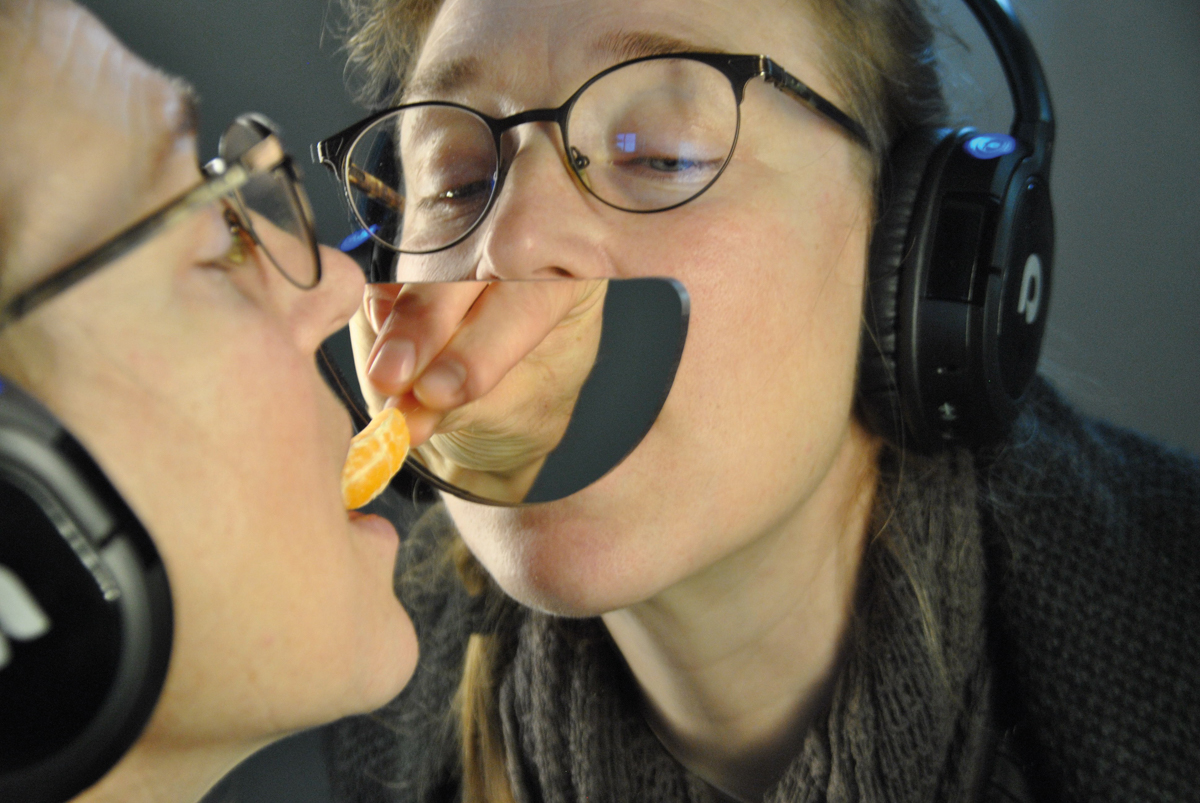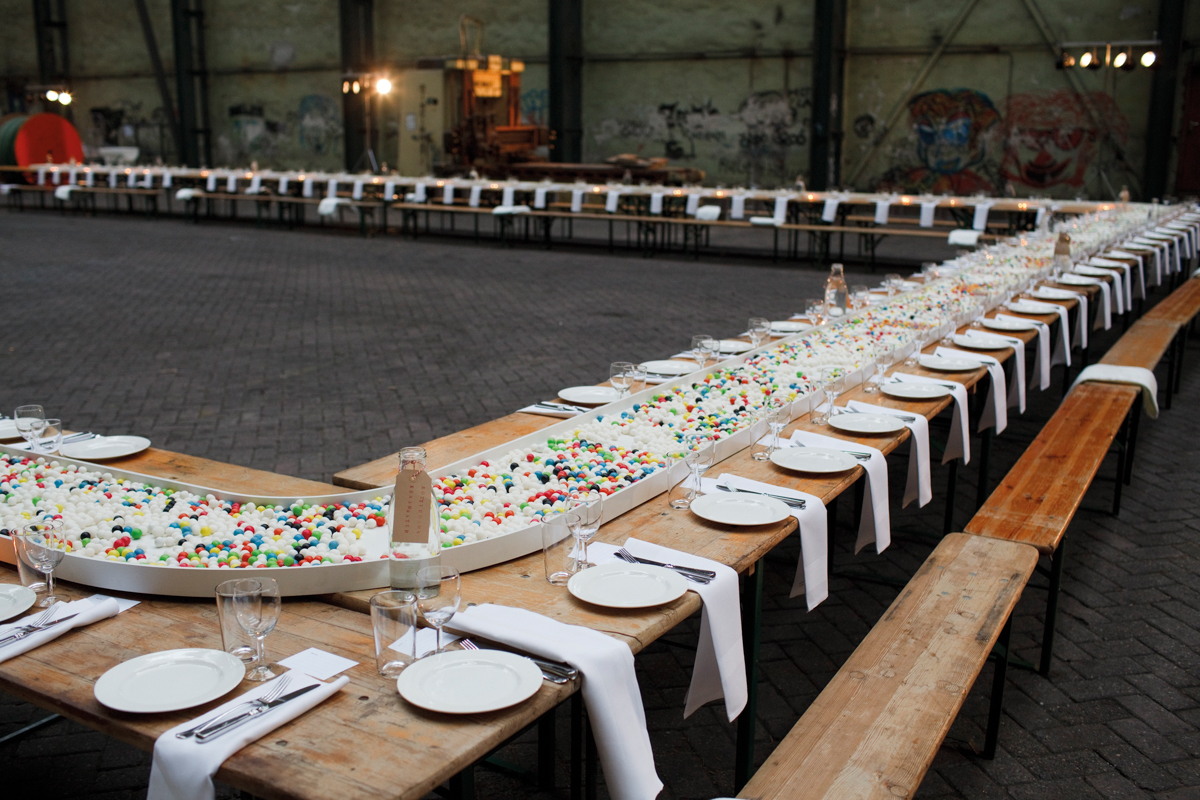art4d in conversation with the world’s first eating designer on how the experience of eating can raise awareness about food issues

Portrait: Ilja Keizer
art4d: Some artists also use food as a material or language to make works of art, do you think there is a difference between your work and theirs?
Marije Vogelzang: The difference between design and art is something that is always discussed and I think I don’t really care. Some projects that I do are very much design like when I make a concept for a supermarket chain, a room service or a hotel, for example, it’s very functional. But when I make this kind of performance, you could say that it’s more of an artistic approach. But still, I make these installations and performances, they’re the tools that make people interact and engage with each other. Therefore, they are still very functional because they serve as a tool for interactions. So I feel that my work still comes from a design background but I can’t say that all the artists are not working in design. I like that it is fluid and I like that it’s not defined.
art4d: How has eating design become a profession?
MV: When I first started working with food there were a handful of people who were designers focusing on food around the world. So food designers or eating designers, that’s just a name. I don’t know if I’m the first designer working with food but I’m the first eating designer, that’s true. But it took me a couple of years because when I first started people didn’t really understand why do we need this and why do you want this. But now I get farmers and businesses coming to me saying that things need to change. If we continue eating like this, we will ruin our planet. So we have to find different ways. We have to find more creative solutions. In our daily life, we see that many people are eating alone, and they feel lonely. People don’t know how to cook anymore. The rituals that we once had and the religious aspect that we once had in our life, we don’t have that anymore. So I feel that there’s a need to create new rituals, to create a different food culture and also to be more connected to the food. Because, I imagine if you live in Hong Kong, it’s so hard to really get in touch with where your food was grown because you can’t see it. You just buy something and think that the label is right but you have no idea.
art4d: So you’re saying that nowadays people are losing connections with their food and where it is being grown and so on.
MV: That’s one thing. But it’s not the only thing.
art4d: What else do you want to change then?
MV: The whole food system is sick, so there are many issues. Bees are dying, we don’t know where food came from, young children think milk comes from factories not a cow, oceans are polluted, the obesity rate is rising. You have this whole list of problems but I don’t think that’s all. Underneath that there’s food culture, the way we eat, how grateful we are for food, how we treat food, how much respect can we have, how can we enjoy food and really treat it the way we should. That’s another thing. It’s not only the big issues. I think if you’re a designer and you’re just making a product that makes people really understand the value of food, that could also be a good idea.

Vogelzang was commissioned to design ‘Edible Reflections’ (2016), an interactive installation that aimed to create a better connection between the Swedish local and immigrants. The reflective mirror was cut in a mouth-shaped hole to allow for people from both sides to see only the mouths of each other. The participants listened to a different story on headphones and interacted together through the feeding of different foods.
Vogelzang ออกแบบผลงานอินสตอลเลชั่นแบบมีปฏิสัมพันธ์ขึ้นในชื่อ Edible Reflections (2016) เพื่อเชื่อมความสัมพันธ์ระหว่างชาวสวีเดนท้องถิ่นกับผู้อพยพ กระจกสะท้อนสองด้านถูกตัดออกเป็นรูปปากเพื่อให้ทั้งสองฝั่งเห็นเพียงปากของกันและกัน ผู้เข้าร่วมทั้งสองฝั่งจะสวมหูฟังที่มีเรื่องราวต่างกัน และมีปฏิสัมพันธ์ระหว่างกันผ่านการป้อนอาหารชนิดต่างๆ

‘Bits ‘N Byte’ (2010), an eating experience design project that Vogelzang collaborated with Dutch interior designer, Robin Van Der Werff to make a 60-meter-long table at the Museum Bojimans Van Beuningen in Rotterdam. In this project, various dishes of round-shaped foods were transported along low-tech conveyor belt full of tiny colorful balls.
‘Bits ‘n Byte’ (2010) ผลงานออกแบบประสบการณ์การกินที่ Vogelzang ทำงานร่วมกับอินทีเรียดีไซเนอร์ Robin van der Werff ในการออกแบบโต๊ะอาหารยาว 60 เมตร ขึ้นที่ Museum Boijmans Van Beuningen ในรอตเตอร์ดัม ในงานชิ้นนี้ อาหารรูปทรงกลมแต่ละจานถูกส่งต่อด้วยสายพานแบบ low tech ที่บรรจุไปด้วยลูกบอลทรงกลมขนาดจิ๋วหลากสี
art4d: ศิลปินบางคนใช้อาหารในฐานะของวัสดุหรือภาษาในการสร้างงานศิลปะ คุณคิดว่างานของคุณแตกต่างจากงานประเภทนี้ไหม
Marije Vogelzang: ความแตกต่างระหว่างงานออกแบบกับงานศิลปะมันเป็นสิ่งที่มีการถกเถียงกันมาตลอด ซึ่งฉันคิดว่าฉันไม่ได้สนใจมันสักเท่าไร บางโปรเจ็คต์ที่ฉันทำมีความเป็นงานออกแบบมาก อย่างตอนที่ฉันคิดคอนเซ็ปต์ให้กับเครือข่ายซุปเปอร์มาร์เก็ตรายหนึ่ง หรืองานที่ฉันออกแบบเมนูรูมเซอร์วิส ไปจนถึงการทำงานกับโรงแรม ทั้งหมดนี้ก็เป็นโปรเจ็คต์ที่เน้นเรื่องของฟังก์ชั่นการใช้งานมากๆ แต่เวลาที่ฉันแสดงงานที่มีลักษณะของความเป็นเพอฟอร์แมนซ์แบบนี้ คุณก็อาจจะพูดได้ว่ามันเป็นการสร้างงานเชิงศิลปะมากกว่า แต่ถึงอย่างนั้น ฉันก็สร้างผลงานอินสตอลเลชั่นและเพอฟอร์แมนซ์พวกนี้เพราะมันเป็นเครื่องมือที่ทำให้คนมีปฏิสัมพันธ์และมีส่วนร่วมกัน เพราะฉะนั้นมันก็ยังมีแง่มุมของการใช้งานอยู่ เพราะมันต้องทำหน้าที่เป็นเครื่องมือของการสร้างปฏิสัมพันธ์ ฉันชอบที่มันเคลื่อนย้ายถ่ายเทไปมาระหว่างกัน แล้วก็ไม่ได้มีนิยามอะไรมาครอบไว้มากกว่า
art4d: การออกแบบการกินมันกลายมาเป็นอาชีพได้อย่างไร
MV: ตอนที่ฉันเริ่มทำงานกับอาหารใหม่ๆ ก็มีนักออกแบบอยู่จำนวนหนึ่งเลยทั่วโลกที่มีความสนใจในการทำงานกับอาหาร คือไม่ว่าจะเป็นนักออกแบบอาหาร หรือว่านักออกแบบการกินก็ตาม มันก็เป็นแค่ชื่อเรียก ฉันไม่รู้ว่าฉันเป็นนักออกแบบคนแรกที่ทำงานกับอาหารจริงๆ หรือเปล่า แต่ถ้าคุณจะบอกว่าฉันเป็นนักออกแบบการกินคนแรก นั่นก็อาจจะจริง แต่ถึงอย่างนั้น ฉันก็ใช้เวลาอยู่สองสามปีเลยตอนที่เพิ่งเริ่มทำงานใหม่ๆ เพราะคนก็จะไม่ค่อยเข้าใจกันว่าทำไมเราถึงต้องมีการออกแบบการกินด้วย หรือว่าเราจะต้องการมันไปทำไม แต่ตอนนี้ฉันได้พูดคุยกับชาวนาหรือผู้ประกอบการที่เข้ามาหาฉันแล้วก็บอกว่าสิ่งต่างๆ ต้องได้รับการเปลี่ยนแปลงแล้วเพราะถ้าเรายังบริโภคในแบบที่เรากำลังทำกันอยู่ เราจะลงเอยด้วยการทำาลายโลกใบนี้ในที่สุด ดังนั้นเราต้องหาหนทางอื่นๆ เราต้องหาทางออกที่สร้างสรรค์กว่านี้ในชีวิตประจำาวัน เราเห็นคนมากมายนั่งกินอาหารคนเดียว แล้วพวกเขาก็รู้สึกเหงาคนสมัยนี้ทำกับข้าวไม่เป็นกันแล้ว พิธีกรรมต่างๆ ที่เราเคยมี แง่มุมทางศาสนาและจิตวิญญาณที่เคยมีอยู่ในชีวิตเรา เราไม่มีสิ่งเหล่านั้นอีกต่อไปแล้ว ฉันก็เลยรู้สึกว่ามันจำเป็นที่เราจะต้องสร้างพิธีกรรมใหม่ๆ สร้างวัฒนธรรมอาหารใหม่ๆ และสร้างความสัมพันธ์กับอาหารที่เรากินขึ้นมาให้มากกว่านี้ เพราะฉันลองจินตนาการดูว่าถ้าคุณอยู่ในฮ่องกง มันดูจะเป็นเรื่องยากมากที่คุณจะรับรู้ว่าอาหารที่คุณกินมันมาจากไหนหรือปลูกขึ้นมาอย่างไร เพราะคุณไม่เห็นมัน คุณก็แค่ซื้ออะไรบางอย่างมา คุณอาจจะอ่านฉลากดูว่ามันใช่สิ่งที่คุณอยากซื้อหรือเปล่า แต่เอาเข้าจริงๆ แล้วคุณก็ไม่รู้เลยว่ามันมาจากไหน
art4d: คุณกำลังบอกว่าปัจจุบันนี้คนกำลังสูญเสียความสัมพันธ์ที่พวกเขาเคยมีกับอาหารและต้นกำาเนิดของมัน
MV: นั่นก็เป็นเรื่องหนึ่ง แต่ไม่ใช่ทั้งหมด
art4d: มีอะไรที่คุณอยากเปลี่ยนแปลงอีกบ้าง
MV: ฉันคิดว่าระบบอาหารของเรากำลังป่วยหนัก มันจึงมีประเด็นปัญหามากมาย ผึ้งกำลังตายลง เราไม่รู้ว่าอาหารที่เรากินมีต้นกำเนิดมาจากที่ไหน เด็กสมัยนี้คิดว่านมมาจากโรงงาน ไม่ใช่จากวัว มหาสมุทรกำลังเผชิญกับการปนเปื้อนอย่างหนัก อัตราคนเป็นโรคอ้วนก็เพิ่มขึ้นเรื่อยๆ เรามีปัญหายาวเป็นหางว่าว แต่ฉันไม่คิดว่ามันจะหยุดอยู่ที่แค่นั้นหรอก ภายใต้สิ่งเหล่านั้นมันมีวัฒนธรรมอาหาร วิธีที่เราบริโภค คำถามที่เราต้องถามตัวเองคือเรารู้สึกขอบคุณแค่ไหนกับอาหารที่เรามีกินอยู่ตอนนี้ เราคำนึงถึงและปฏิบัติต่ออาหารอย่างไร เราจะมีความสุขกับมันและปฏิบัติต่ออาหารอย่างที่ควรจะเป็นได้อย่างไร
Read the full article on art4d No.263 | Click Here
INTERVIEWED BY: PAPHOP KERDSUP
PHOTO COURTESY OF STUDIO MARIJE VOGELZANG
marijevogelzang.nl

